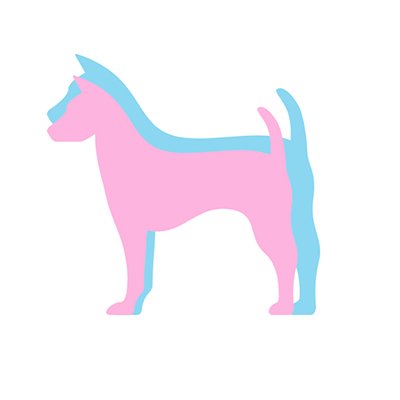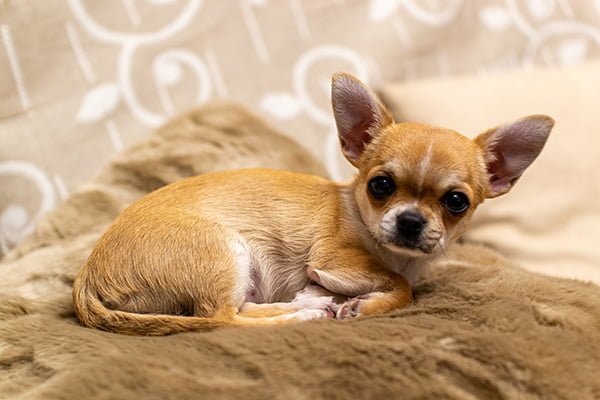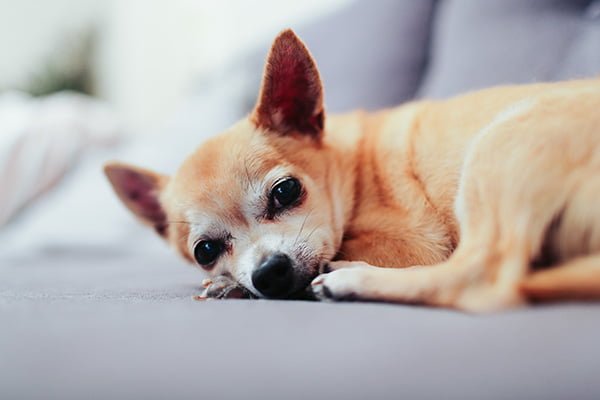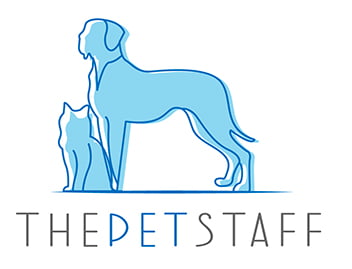Small, adorable, and endlessly entertaining, teacup Chihuahuas are the pocket-sized pooches that have taken the world by storm. These miniature marvels may be small in size, but they pack a punch when it comes to personality and charm. Whether you're looking for a loyal lap dog, a lively companion for daily adventures, or simply a new furry friend to brighten up your day, miniature Chihuahuas are the perfect choice for those seeking a tiny but mighty canine companion.
Join us as we explore everything you need to know about these pint-sized pups, from their history and temperament to their unique care requirements and more, so you can learn if this dog breed is right for you.
Breed Characteristics
Temperament | Lively, alert, and loyal |
Intelligence | High |
Affection/Friendliness | Affectionate and loyal |
Trainability | Moderately trainable |
Mental Stimulation | Requires mental stimulation |
Exercise Needs | Low |
Apartment Living | Suitable for apartment living |
Family Friendly | Generally good with older children, can be wary of younger ones |
Pet Friendly | Can be wary of other dogs, early socialization is important |
Drooling Level | Low |
Energy Level | Low to moderate |
Loneliness Tolerance | Prefers company, may experience separation anxiety if left alone for long periods |
Adaptability | Adapts well to various environments |
Tendency to bark | High |
Origin
Teacup chihuahua dog is also referred to as miniature chihuahua, mini toy chihuahua, a tiny chihuahua, teacup chi, or pocket size, are all ways to describe this mini chihuahua breed. Standard and teacup chihuahuas have the same history and origin, with the only difference being their size. Chihuahuas have strong ties to the Mayans from Central America and are descendants of the Techichi breed, becoming their own around the 9th century. The Techichi breed was originally believed to be guardians of the afterlife by the Mayans.
The breed evolved and became the dog we know today around the year 1850 and was officially named the "Chihuahua" after the Mexican state of the same name. These dogs were introduced to the United States around the year 1884. Today, chihuahuas are referred to as "teacup" because of their size, as they are selectively bred by the smallest of litters.
Teacup chihuahua is actually not recognized as their own breed by the American Kennel Club as they are grouped in with purebred chihuahua.

Breed Overview
Height: 6-9"
Weight: Up to 4 lbs
Height: 6-9"
Weight: Up to 4 lbs
Breed Group
Toy
Life Span
12-20 years
Coat
Smooth or long
Coat Length
Short to medium
Hypoallergenic
No
Shedding Level
Low to moderate
Size
Teacup chihuahuas are also often called "micro" chihuahuas because of their astonishingly small size. Among other teacup dog breeds, like the Yorkie, Maltese, and poodle, teacup chihuahuas are typically the smallest.
Teacup chihuahua puppies are usually born at a weight of 2.5 to 5.5oz. Like most breeds, teacup chihuahuas aren't fully grown until about ten months of age. Even so, when fully grown, this breed usually stands at the height of 6 inches and weighs about three pounds. Some teacups can grow to be just slightly smaller than a standard chihuahua, but most are significantly smaller.
Personality
The personality of teacup chihuahuas is so large that it makes up for their small size. They are extremely loyal and often considered lap dogs because they like to be close to their owners and love attention from their owners. Teacup chihuahuas tend to become very dependent on their owners and often have separation anxiety if left alone for too long. Luckily, because they are small, it makes it easier to travel, alleviating the issue of potential separation anxiety.
Teacup chihuahuas, like standard, can also become feisty in certain situations when they feel threatened or sometimes around strangers. They are actually considered one of the more aggressive breeds due to their defensive tendencies. With the right socialization and training at a young age, this reaction can be tamed. For these reasons, owning a teacup chihuahua is recommended for advanced dog owners or someone with experience.
Temperament
Because of their potential for aggression, this breed is not always the best fit for a home with small children or an owner that is not home often. These tiny teacup chihuahua dogs can be good with children in certain circumstances, typically not with very young children or if the dog has not been socialized or trained. When approached too quickly or enthusiastically, these dogs will usually bark and often nip, which could cause injury to a child.
Depending on their personality and previous socialization, these dogs can also be reactive to other dogs and pets in the home. Characteristically, the sassiness of these dogs doesn't always allow them to get along with other animals, especially large-breed dogs. Oftentimes, though, they generally get along with other smaller breed dogs.

Image Source: Unsplash
Diet/ Nutritional needs
Like all dogs, teacup chihuahuas are omnivores and should eat a healthy, nutritionally-dense diet. A balanced diet for these dogs can be as simple as a mix of dry and wet dog food or even just dry kibble. Because they are so small, these dogs really only need to eat about a ½ cup of food per day, which can be split over two meals.
For specific diet recommendations, contact your veterinarian.
Activity/ Exercise needs
Even though these dogs are small, they have a large personalities and are fairly active. Teacup chihuahuas should be mentally and physically stimulated on a daily basis to remain healthy. Their feistiness will come out when playing with toys, and they may become hyper and destructive to their toys. As an energetic breed, these dogs should exercise frequently, but because they are so small, it is important not to over-exercise them on excessive walks. About 20 minutes of exercise per day should be plenty of them. Be aware of outdoor temperatures when on walks, and dress them in a coat if it is cold outside.
Appearance/ Colors
Teacup chihuahuas can be any of the same colors as standard chihuahuas. These colors include cream, tan, gold, chocolate, merle, white, black, and silver. Their features, such as large pointed ears, large heads, and bulging eyes, also match those of the standard-bred chihuahua.
Grooming needs
These dogs can have either long or short coats. Short-haired chihuahuas are more common, but long-haired teacup chihuahuas are possible and have longer, straighter, wiry hair. Depending on the coat type, their grooming needs require low to average maintenance. Shedding may also be common for both long and short coats. Frequent brushing is especially important in long-haired dogs to prevent any matting or tangling.
Adaptability
Because these are small dogs, they can adapt to any type of living, from a small apartment to a large home. As long as they can be near you throughout the day, they don't need too much of their own space. Even when staying active, as long as they have toys to play with, they don't require an excessive amount of space to be active and play. Barking may be persistent with these dogs, so it is a factor to consider when deciding if they are a good fit for you, especially if you live in an apartment or condo.
With the appropriate training and socialization, these dogs can learn to control their feistiness and aggression. This means that they can be good family pets and adapt to having other pets in the home if necessary.
Trainability
These dogs are very energetic and typically less intelligent than some other breeds, such as working dogs. This makes teacup chihuahuas more difficult to train. It is important to train your dog to allow them to be socialized in certain situations and become more independent, depending on your lifestyle. They can usually be potty trained fairly quickly and become familiar with basic demands, but their stubbornness can make it stressful to train them for more significant tasks.
Teacup Chihuahua Price
The price of these teacup dogs can vary widely depending on several factors, including the dog's age, lineage, pedigree, and location. On average, a teacup chihuahua cost anywhere from a few hundred dollars to several thousand dollars. Adult teacup chihuahuas are typically about half the price of puppies.
It is worth noting that it is important to do your research on reputable teacup chihuahua breeders who prioritizes the health and well-being of their tiny dogs over profit. Otherwise, you will end up with a chihuahua puppy who may be at greater risk for health issues.
Prior to getting teacup puppies from a reputable breeder, consider checking out your local shelter and rescues first. This can be cost-effective and rewarding in the result.

Image Source: Unsplash
Life expectancy
The average lifespan of a teacup is not far off from that of a standard-bred chihuahua, at 7 to 12 years. But your dog can live longer. It's important to bring your dog to your regular veterinarian at least annually for a regular exam to keep them as healthy as possible.
Potential Health Issues
Like all breeds, there are specific diseases and health issues specific to teacup chihuahuas. These include genetic diseases and other health problems such as luxating patella, hypoglycemia, heart disease, periodontal disease, and eye diseases.
Patellar Luxation
Patellar luxation refers to misplacement and movement of the kneecaps. This is a common issue in smaller dogs that can cause lameness and pain in the hind legs. Signs that this might be happening to your dog include any limping or an abnormal walk or run similar to a skip or hop.
To prevent and manage patellar luxation in teacup Chihuahuas, it's important to provide a low-impact exercise routine, maintain a healthy weight, and avoid activities that put excessive stress on the joints. Additionally, regular veterinary check-ups and monitoring of joint function may be necessary for dogs with a history of joint problems or other risk factors.
Hypoglycemia
Hypoglycemia is a common and potentially serious health concern in teacup Chihuahuas and other toy breeds. Also known as low blood sugar, a variety of factors, including stress, inadequate nutrition, and strenuous exercise, can cause hypoglycemia. Symptoms of hypoglycemia in teacup Chihuahuas can include weakness, lethargy, tremors, seizures, and even coma or death if left untreated.
Teacup Chihuahuas are particularly susceptible to hypoglycemia due to their small size and high metabolism, which means they burn through glucose (sugar) faster than larger dogs. Additionally, they have less body fat to provide energy reserves in times of stress or illness.
To prevent and manage hypoglycemia in teacup Chihuahuas, it's important to provide them with a well-balanced diet that includes high-quality protein, healthy fats, and complex carbohydrates. It's also important to feed them frequent, small meals throughout the day to keep their blood sugar levels stable. In addition, regular veterinary check-ups and monitoring of blood glucose levels may be necessary to catch and address hypoglycemia early on.
Heart Disease
Heart disease is a serious and potentially life-threatening condition that can affect teacup Chihuahuas, as well as many other small dog breeds. This condition can include a variety of conditions, such as mitral valve disease, patent ductus arteriosus, and dilated cardiomyopathy.
To prevent and manage heart disease in teacup Chihuahuas, it's important to establish a regular exercise routine, maintain a healthy weight, and provide a well-balanced, high-quality diet. Additionally, regular veterinary check-ups and monitoring of cardiac function may be necessary for dogs with a history of heart disease or other risk factors.
Periodontal disease
Periodontal disease is a common and serious dental condition that affects many dogs, including teacup Chihuahuas. It is caused by a buildup of bacteria and plaque on the teeth and gums, which can lead to inflammation, infection, and even tooth loss if left untreated.
Teacup Chihuahuas are particularly prone to periodontal disease due to their small size, which can result in overcrowding and misalignment of teeth. Additionally, their delicate teeth and gums are more susceptible to damage and decay.
To prevent and manage periodontal disease in teacup Chihuahuas, it's important to establish a regular dental hygiene routine. This can include daily brushing with a dog-specific toothpaste, regular dental cleanings from a veterinarian, and providing dental chews or toys that promote healthy teeth and gums.
Eye diseases
Teacup Chihuahuas are known for their big, bright eyes, but unfortunately, they are also prone to a number of eye diseases and conditions. These can include cataracts, glaucoma, corneal ulcers, and progressive retinal atrophy (PRA).
To prevent and manage eye diseases in teacup Chihuahuas, it's important to establish a regular eye care routine. This can include daily cleaning of the eyes with a warm, damp cloth, regular veterinary check-ups, and prompt attention to any signs of discomfort or abnormal behavior.
